Internet Security Report | Cyber Security
VerifiedAdded on 2022/08/19
|12
|2590
|11
AI Summary
Contribute Materials
Your contribution can guide someone’s learning journey. Share your
documents today.
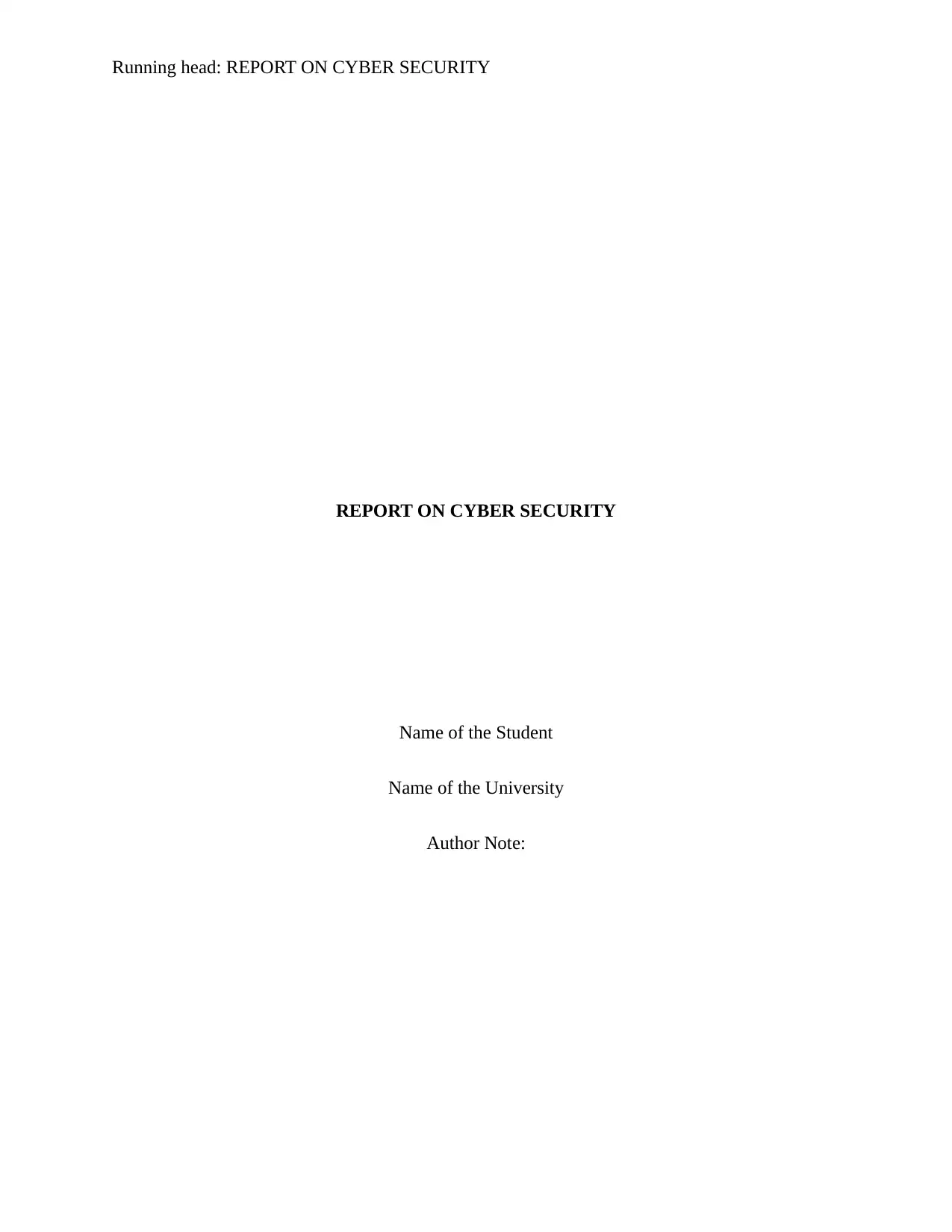
Running head: REPORT ON CYBER SECURITY
REPORT ON CYBER SECURITY
Name of the Student
Name of the University
Author Note:
REPORT ON CYBER SECURITY
Name of the Student
Name of the University
Author Note:
Secure Best Marks with AI Grader
Need help grading? Try our AI Grader for instant feedback on your assignments.

1Cyber Security
Executive Summary:
Internet security is big topic which is quite essential for communication system of cyber
café, however this is extremely wide and dynamic in scope. It is reason that several organizations
heavily invest in highly trained specialists and dedicated security infrastructure. This paper
provides the security plan, security measures, training and security policies for maintaining a
safe and secure environment for the systems of the cyber café. It is observed that cyber threats
spyware and virus are among big threat of internet for the users of cyber café. This paper
provides security measures and policies to counter measure the threats of cyber café.
Executive Summary:
Internet security is big topic which is quite essential for communication system of cyber
café, however this is extremely wide and dynamic in scope. It is reason that several organizations
heavily invest in highly trained specialists and dedicated security infrastructure. This paper
provides the security plan, security measures, training and security policies for maintaining a
safe and secure environment for the systems of the cyber café. It is observed that cyber threats
spyware and virus are among big threat of internet for the users of cyber café. This paper
provides security measures and policies to counter measure the threats of cyber café.
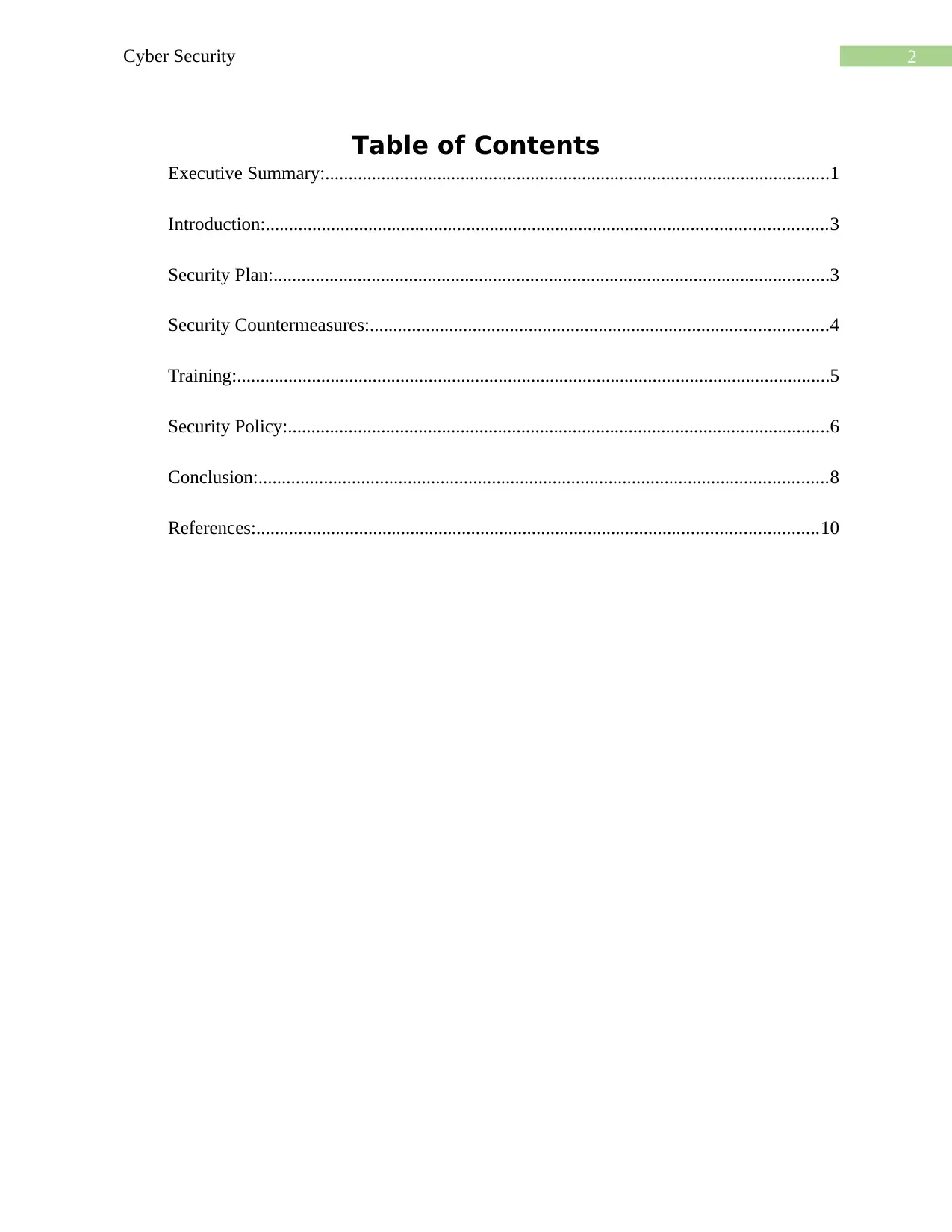
2Cyber Security
Table of Contents
Executive Summary:............................................................................................................1
Introduction:........................................................................................................................3
Security Plan:.......................................................................................................................3
Security Countermeasures:..................................................................................................4
Training:...............................................................................................................................5
Security Policy:....................................................................................................................6
Conclusion:..........................................................................................................................8
References:........................................................................................................................10
Table of Contents
Executive Summary:............................................................................................................1
Introduction:........................................................................................................................3
Security Plan:.......................................................................................................................3
Security Countermeasures:..................................................................................................4
Training:...............................................................................................................................5
Security Policy:....................................................................................................................6
Conclusion:..........................................................................................................................8
References:........................................................................................................................10
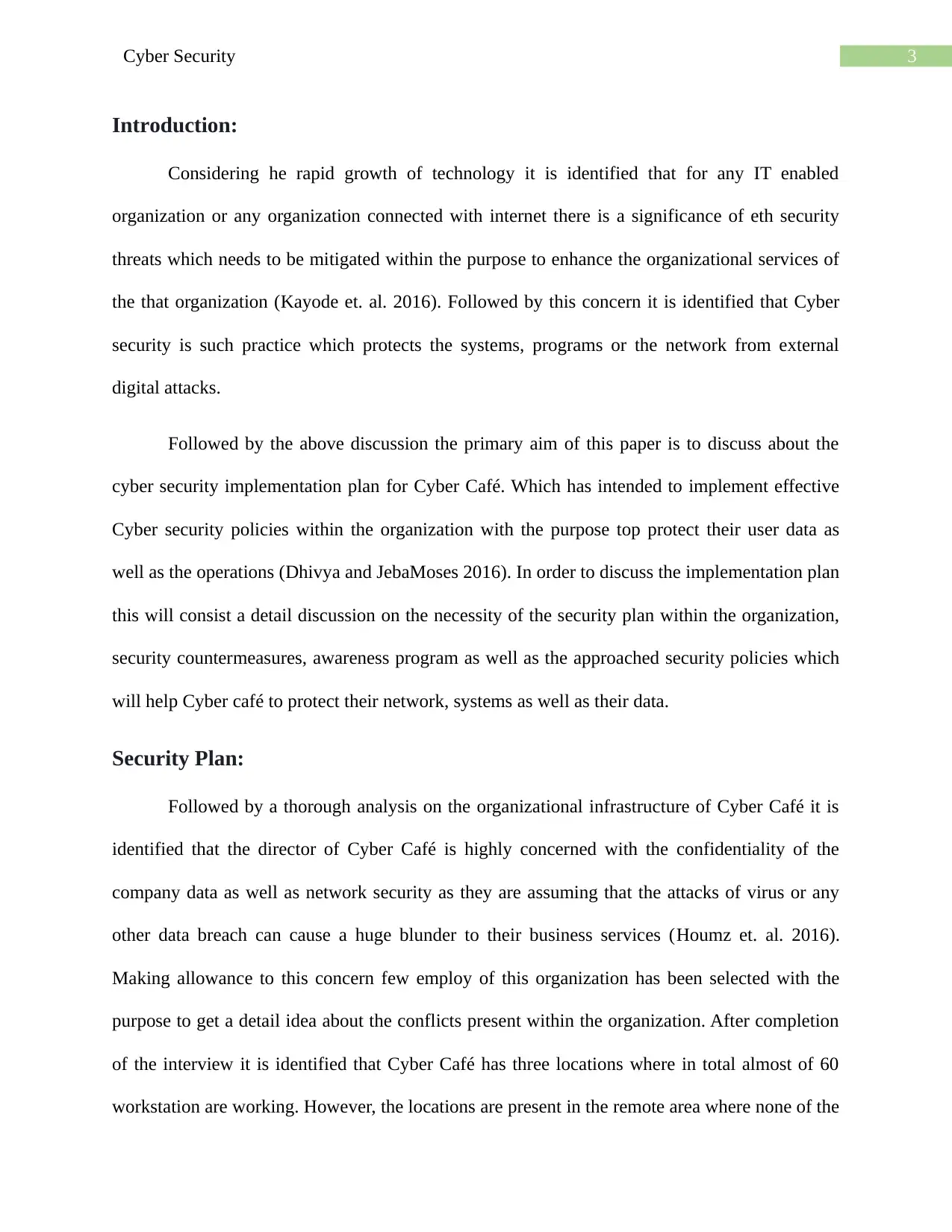
3Cyber Security
Introduction:
Considering he rapid growth of technology it is identified that for any IT enabled
organization or any organization connected with internet there is a significance of eth security
threats which needs to be mitigated within the purpose to enhance the organizational services of
the that organization (Kayode et. al. 2016). Followed by this concern it is identified that Cyber
security is such practice which protects the systems, programs or the network from external
digital attacks.
Followed by the above discussion the primary aim of this paper is to discuss about the
cyber security implementation plan for Cyber Café. Which has intended to implement effective
Cyber security policies within the organization with the purpose top protect their user data as
well as the operations (Dhivya and JebaMoses 2016). In order to discuss the implementation plan
this will consist a detail discussion on the necessity of the security plan within the organization,
security countermeasures, awareness program as well as the approached security policies which
will help Cyber café to protect their network, systems as well as their data.
Security Plan:
Followed by a thorough analysis on the organizational infrastructure of Cyber Café it is
identified that the director of Cyber Café is highly concerned with the confidentiality of the
company data as well as network security as they are assuming that the attacks of virus or any
other data breach can cause a huge blunder to their business services (Houmz et. al. 2016).
Making allowance to this concern few employ of this organization has been selected with the
purpose to get a detail idea about the conflicts present within the organization. After completion
of the interview it is identified that Cyber Café has three locations where in total almost of 60
workstation are working. However, the locations are present in the remote area where none of the
Introduction:
Considering he rapid growth of technology it is identified that for any IT enabled
organization or any organization connected with internet there is a significance of eth security
threats which needs to be mitigated within the purpose to enhance the organizational services of
the that organization (Kayode et. al. 2016). Followed by this concern it is identified that Cyber
security is such practice which protects the systems, programs or the network from external
digital attacks.
Followed by the above discussion the primary aim of this paper is to discuss about the
cyber security implementation plan for Cyber Café. Which has intended to implement effective
Cyber security policies within the organization with the purpose top protect their user data as
well as the operations (Dhivya and JebaMoses 2016). In order to discuss the implementation plan
this will consist a detail discussion on the necessity of the security plan within the organization,
security countermeasures, awareness program as well as the approached security policies which
will help Cyber café to protect their network, systems as well as their data.
Security Plan:
Followed by a thorough analysis on the organizational infrastructure of Cyber Café it is
identified that the director of Cyber Café is highly concerned with the confidentiality of the
company data as well as network security as they are assuming that the attacks of virus or any
other data breach can cause a huge blunder to their business services (Houmz et. al. 2016).
Making allowance to this concern few employ of this organization has been selected with the
purpose to get a detail idea about the conflicts present within the organization. After completion
of the interview it is identified that Cyber Café has three locations where in total almost of 60
workstation are working. However, the locations are present in the remote area where none of the
Secure Best Marks with AI Grader
Need help grading? Try our AI Grader for instant feedback on your assignments.
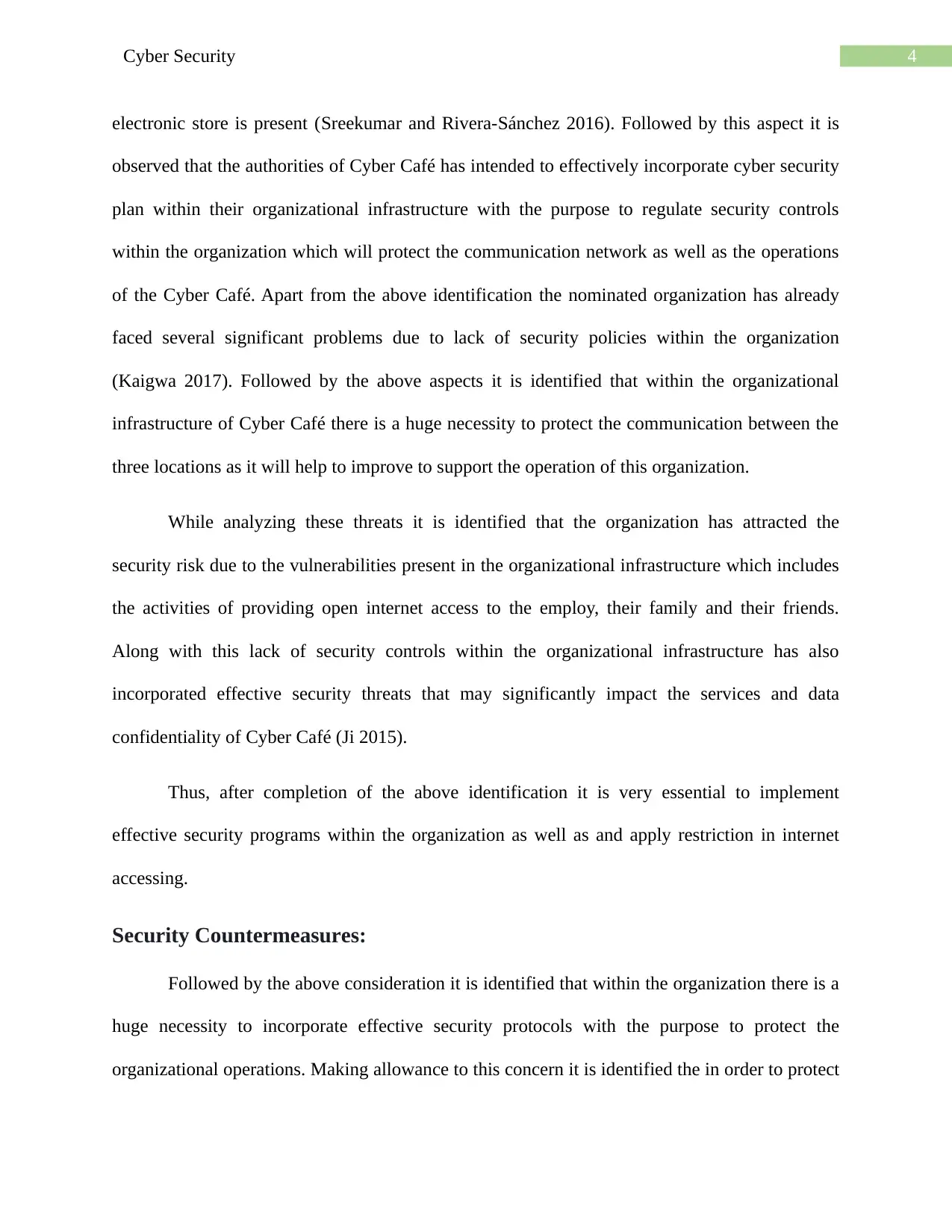
4Cyber Security
electronic store is present (Sreekumar and Rivera-Sánchez 2016). Followed by this aspect it is
observed that the authorities of Cyber Café has intended to effectively incorporate cyber security
plan within their organizational infrastructure with the purpose to regulate security controls
within the organization which will protect the communication network as well as the operations
of the Cyber Café. Apart from the above identification the nominated organization has already
faced several significant problems due to lack of security policies within the organization
(Kaigwa 2017). Followed by the above aspects it is identified that within the organizational
infrastructure of Cyber Café there is a huge necessity to protect the communication between the
three locations as it will help to improve to support the operation of this organization.
While analyzing these threats it is identified that the organization has attracted the
security risk due to the vulnerabilities present in the organizational infrastructure which includes
the activities of providing open internet access to the employ, their family and their friends.
Along with this lack of security controls within the organizational infrastructure has also
incorporated effective security threats that may significantly impact the services and data
confidentiality of Cyber Café (Ji 2015).
Thus, after completion of the above identification it is very essential to implement
effective security programs within the organization as well as and apply restriction in internet
accessing.
Security Countermeasures:
Followed by the above consideration it is identified that within the organization there is a
huge necessity to incorporate effective security protocols with the purpose to protect the
organizational operations. Making allowance to this concern it is identified the in order to protect
electronic store is present (Sreekumar and Rivera-Sánchez 2016). Followed by this aspect it is
observed that the authorities of Cyber Café has intended to effectively incorporate cyber security
plan within their organizational infrastructure with the purpose to regulate security controls
within the organization which will protect the communication network as well as the operations
of the Cyber Café. Apart from the above identification the nominated organization has already
faced several significant problems due to lack of security policies within the organization
(Kaigwa 2017). Followed by the above aspects it is identified that within the organizational
infrastructure of Cyber Café there is a huge necessity to protect the communication between the
three locations as it will help to improve to support the operation of this organization.
While analyzing these threats it is identified that the organization has attracted the
security risk due to the vulnerabilities present in the organizational infrastructure which includes
the activities of providing open internet access to the employ, their family and their friends.
Along with this lack of security controls within the organizational infrastructure has also
incorporated effective security threats that may significantly impact the services and data
confidentiality of Cyber Café (Ji 2015).
Thus, after completion of the above identification it is very essential to implement
effective security programs within the organization as well as and apply restriction in internet
accessing.
Security Countermeasures:
Followed by the above consideration it is identified that within the organization there is a
huge necessity to incorporate effective security protocols with the purpose to protect the
organizational operations. Making allowance to this concern it is identified the in order to protect
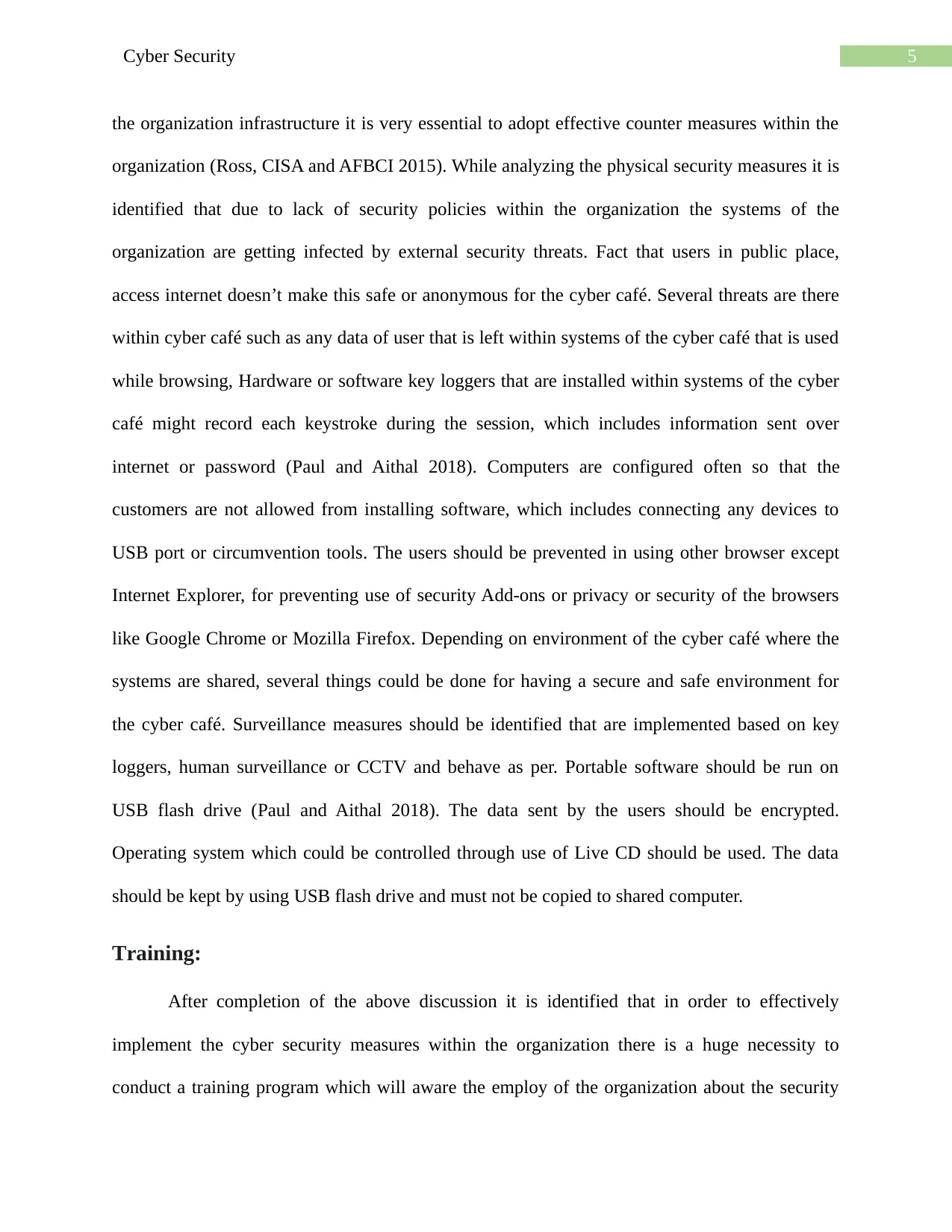
5Cyber Security
the organization infrastructure it is very essential to adopt effective counter measures within the
organization (Ross, CISA and AFBCI 2015). While analyzing the physical security measures it is
identified that due to lack of security policies within the organization the systems of the
organization are getting infected by external security threats. Fact that users in public place,
access internet doesn’t make this safe or anonymous for the cyber café. Several threats are there
within cyber café such as any data of user that is left within systems of the cyber café that is used
while browsing, Hardware or software key loggers that are installed within systems of the cyber
café might record each keystroke during the session, which includes information sent over
internet or password (Paul and Aithal 2018). Computers are configured often so that the
customers are not allowed from installing software, which includes connecting any devices to
USB port or circumvention tools. The users should be prevented in using other browser except
Internet Explorer, for preventing use of security Add-ons or privacy or security of the browsers
like Google Chrome or Mozilla Firefox. Depending on environment of the cyber café where the
systems are shared, several things could be done for having a secure and safe environment for
the cyber café. Surveillance measures should be identified that are implemented based on key
loggers, human surveillance or CCTV and behave as per. Portable software should be run on
USB flash drive (Paul and Aithal 2018). The data sent by the users should be encrypted.
Operating system which could be controlled through use of Live CD should be used. The data
should be kept by using USB flash drive and must not be copied to shared computer.
Training:
After completion of the above discussion it is identified that in order to effectively
implement the cyber security measures within the organization there is a huge necessity to
conduct a training program which will aware the employ of the organization about the security
the organization infrastructure it is very essential to adopt effective counter measures within the
organization (Ross, CISA and AFBCI 2015). While analyzing the physical security measures it is
identified that due to lack of security policies within the organization the systems of the
organization are getting infected by external security threats. Fact that users in public place,
access internet doesn’t make this safe or anonymous for the cyber café. Several threats are there
within cyber café such as any data of user that is left within systems of the cyber café that is used
while browsing, Hardware or software key loggers that are installed within systems of the cyber
café might record each keystroke during the session, which includes information sent over
internet or password (Paul and Aithal 2018). Computers are configured often so that the
customers are not allowed from installing software, which includes connecting any devices to
USB port or circumvention tools. The users should be prevented in using other browser except
Internet Explorer, for preventing use of security Add-ons or privacy or security of the browsers
like Google Chrome or Mozilla Firefox. Depending on environment of the cyber café where the
systems are shared, several things could be done for having a secure and safe environment for
the cyber café. Surveillance measures should be identified that are implemented based on key
loggers, human surveillance or CCTV and behave as per. Portable software should be run on
USB flash drive (Paul and Aithal 2018). The data sent by the users should be encrypted.
Operating system which could be controlled through use of Live CD should be used. The data
should be kept by using USB flash drive and must not be copied to shared computer.
Training:
After completion of the above discussion it is identified that in order to effectively
implement the cyber security measures within the organization there is a huge necessity to
conduct a training program which will aware the employ of the organization about the security

6Cyber Security
threats of the organization as well as the security measures which will help to mitigate the
identified threats within the organization (Michel et. al. 2018). The approached training program
will be conducted with identifying the responsibilities of the employs within in the organization.
This process will help to effectively manage the roles and responsibilities of the each employ
present in the organization. Later, it will spread an awareness to secure the sensitive data of the
organization which will help the employ to get an idea of how the operations and the data needs
to be protected within the organizational infrastructure. Making allowance to this activity the
establishment of minimum security awareness program will help the organization to effectively
spread the security awareness to the employ of the organization by computer based training,
emails, notices as well as by other security awareness practices (Caparino 2018).
Along with these aspects it is identified that the in order to protect the operation of the
Cyber Café it is very essential to conduct a depth security awareness training. Which will
conducted based on the level of risk (Urias and Van Leeuwen 2016). In case of high risk the in-
depth security program will conducted which will specialize the roles and manage the risks, in
case of medium to low impact risk the intermediate security awareness and the general security
risks will be conducted which will help to manage the risk as well as provide awareness to all
personnel level.
Security Policy:
Security is an essential consideration while setting up cyber café. Cyber café should be
prepared in dealing with extra potential problems. Shortage of appropriate security could allow
customer in modifying crucial settings which might compromise potentially underlying system
of the cyber café. The users should not be allowed also in installing software in the machines of
cyber café. The owners of cyber café would be accountable for each activity which originates
threats of the organization as well as the security measures which will help to mitigate the
identified threats within the organization (Michel et. al. 2018). The approached training program
will be conducted with identifying the responsibilities of the employs within in the organization.
This process will help to effectively manage the roles and responsibilities of the each employ
present in the organization. Later, it will spread an awareness to secure the sensitive data of the
organization which will help the employ to get an idea of how the operations and the data needs
to be protected within the organizational infrastructure. Making allowance to this activity the
establishment of minimum security awareness program will help the organization to effectively
spread the security awareness to the employ of the organization by computer based training,
emails, notices as well as by other security awareness practices (Caparino 2018).
Along with these aspects it is identified that the in order to protect the operation of the
Cyber Café it is very essential to conduct a depth security awareness training. Which will
conducted based on the level of risk (Urias and Van Leeuwen 2016). In case of high risk the in-
depth security program will conducted which will specialize the roles and manage the risks, in
case of medium to low impact risk the intermediate security awareness and the general security
risks will be conducted which will help to manage the risk as well as provide awareness to all
personnel level.
Security Policy:
Security is an essential consideration while setting up cyber café. Cyber café should be
prepared in dealing with extra potential problems. Shortage of appropriate security could allow
customer in modifying crucial settings which might compromise potentially underlying system
of the cyber café. The users should not be allowed also in installing software in the machines of
cyber café. The owners of cyber café would be accountable for each activity which originates
Paraphrase This Document
Need a fresh take? Get an instant paraphrase of this document with our AI Paraphraser
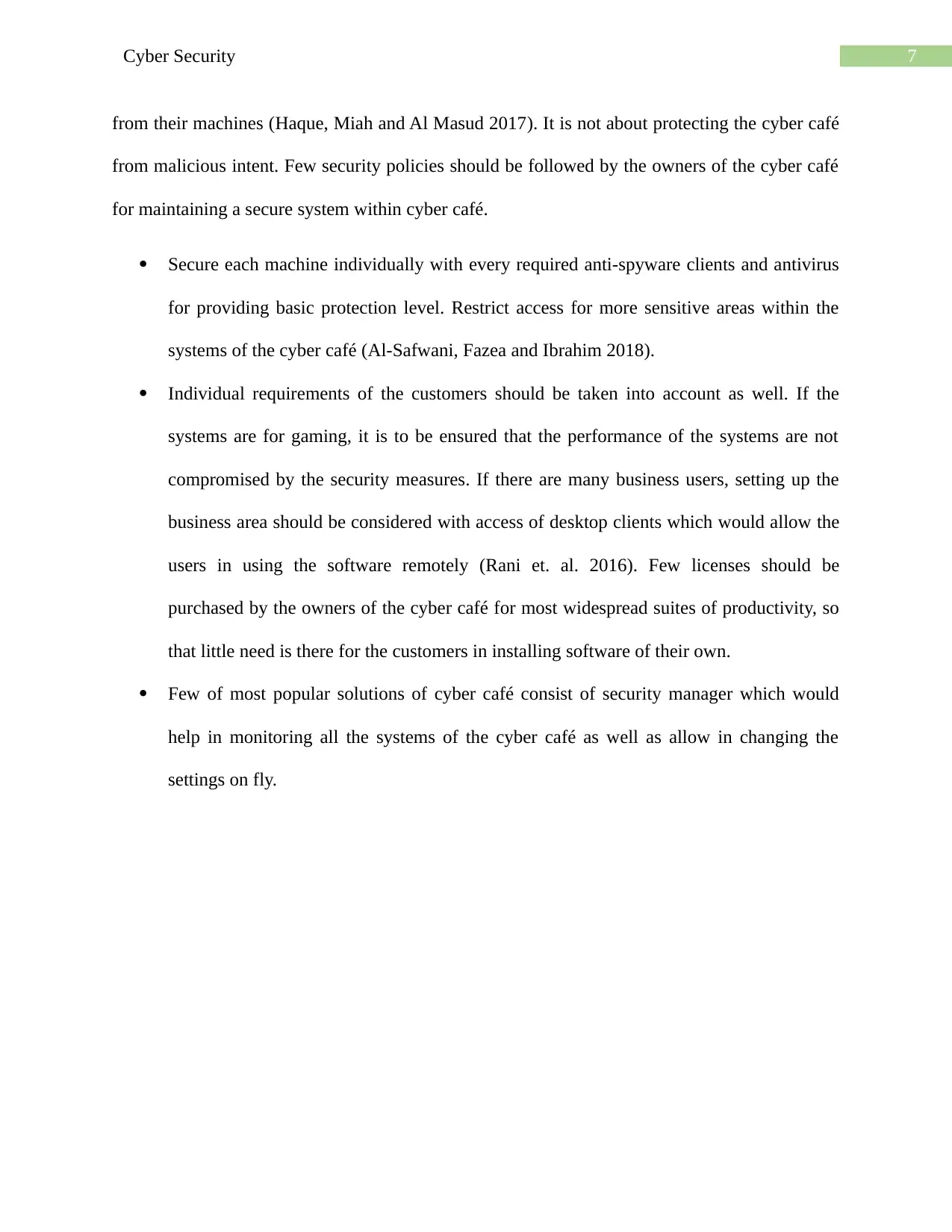
7Cyber Security
from their machines (Haque, Miah and Al Masud 2017). It is not about protecting the cyber café
from malicious intent. Few security policies should be followed by the owners of the cyber café
for maintaining a secure system within cyber café.
Secure each machine individually with every required anti-spyware clients and antivirus
for providing basic protection level. Restrict access for more sensitive areas within the
systems of the cyber café (Al-Safwani, Fazea and Ibrahim 2018).
Individual requirements of the customers should be taken into account as well. If the
systems are for gaming, it is to be ensured that the performance of the systems are not
compromised by the security measures. If there are many business users, setting up the
business area should be considered with access of desktop clients which would allow the
users in using the software remotely (Rani et. al. 2016). Few licenses should be
purchased by the owners of the cyber café for most widespread suites of productivity, so
that little need is there for the customers in installing software of their own.
Few of most popular solutions of cyber café consist of security manager which would
help in monitoring all the systems of the cyber café as well as allow in changing the
settings on fly.
from their machines (Haque, Miah and Al Masud 2017). It is not about protecting the cyber café
from malicious intent. Few security policies should be followed by the owners of the cyber café
for maintaining a secure system within cyber café.
Secure each machine individually with every required anti-spyware clients and antivirus
for providing basic protection level. Restrict access for more sensitive areas within the
systems of the cyber café (Al-Safwani, Fazea and Ibrahim 2018).
Individual requirements of the customers should be taken into account as well. If the
systems are for gaming, it is to be ensured that the performance of the systems are not
compromised by the security measures. If there are many business users, setting up the
business area should be considered with access of desktop clients which would allow the
users in using the software remotely (Rani et. al. 2016). Few licenses should be
purchased by the owners of the cyber café for most widespread suites of productivity, so
that little need is there for the customers in installing software of their own.
Few of most popular solutions of cyber café consist of security manager which would
help in monitoring all the systems of the cyber café as well as allow in changing the
settings on fly.
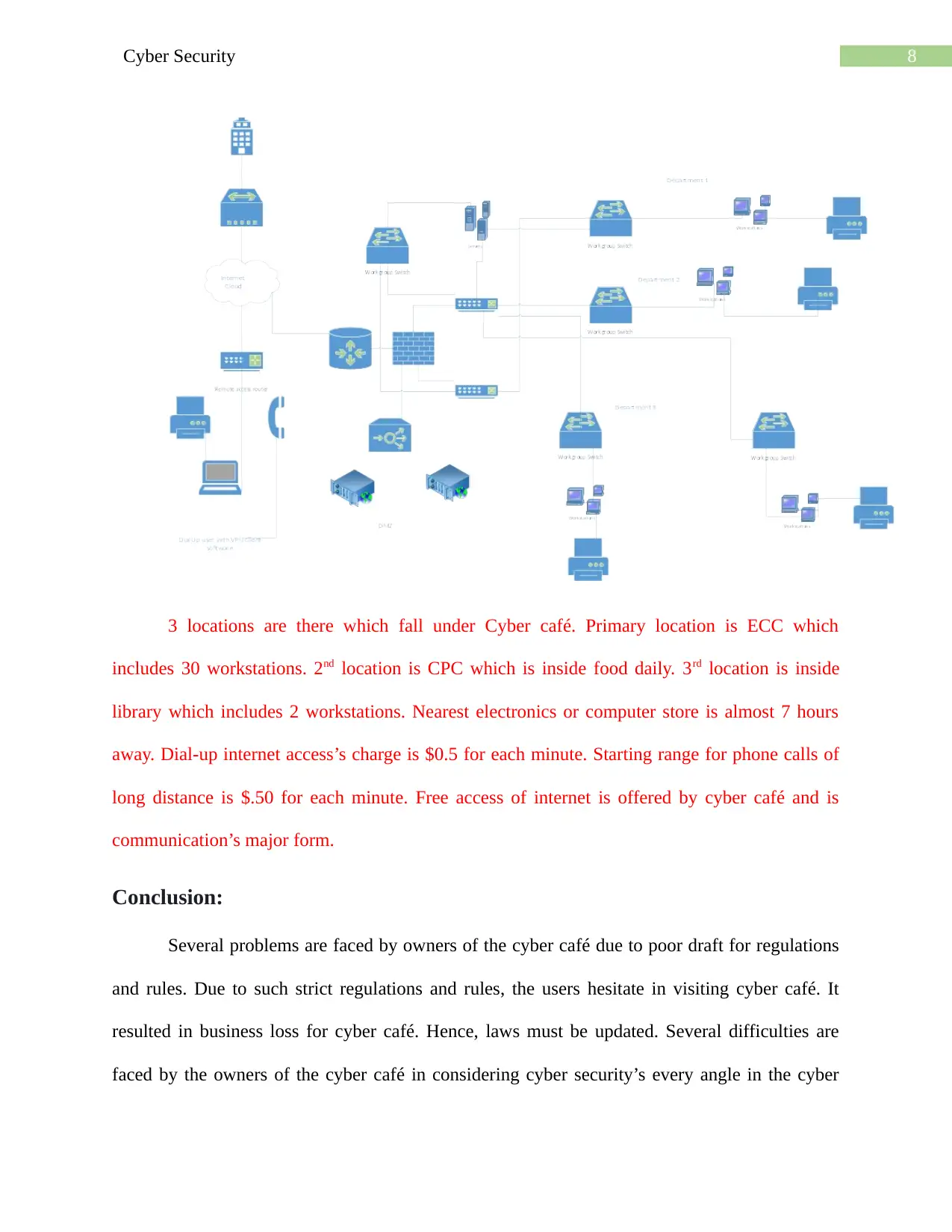
8Cyber Security
3 locations are there which fall under Cyber café. Primary location is ECC which
includes 30 workstations. 2nd location is CPC which is inside food daily. 3rd location is inside
library which includes 2 workstations. Nearest electronics or computer store is almost 7 hours
away. Dial-up internet access’s charge is $0.5 for each minute. Starting range for phone calls of
long distance is $.50 for each minute. Free access of internet is offered by cyber café and is
communication’s major form.
Conclusion:
Several problems are faced by owners of the cyber café due to poor draft for regulations
and rules. Due to such strict regulations and rules, the users hesitate in visiting cyber café. It
resulted in business loss for cyber café. Hence, laws must be updated. Several difficulties are
faced by the owners of the cyber café in considering cyber security’s every angle in the cyber
3 locations are there which fall under Cyber café. Primary location is ECC which
includes 30 workstations. 2nd location is CPC which is inside food daily. 3rd location is inside
library which includes 2 workstations. Nearest electronics or computer store is almost 7 hours
away. Dial-up internet access’s charge is $0.5 for each minute. Starting range for phone calls of
long distance is $.50 for each minute. Free access of internet is offered by cyber café and is
communication’s major form.
Conclusion:
Several problems are faced by owners of the cyber café due to poor draft for regulations
and rules. Due to such strict regulations and rules, the users hesitate in visiting cyber café. It
resulted in business loss for cyber café. Hence, laws must be updated. Several difficulties are
faced by the owners of the cyber café in considering cyber security’s every angle in the cyber
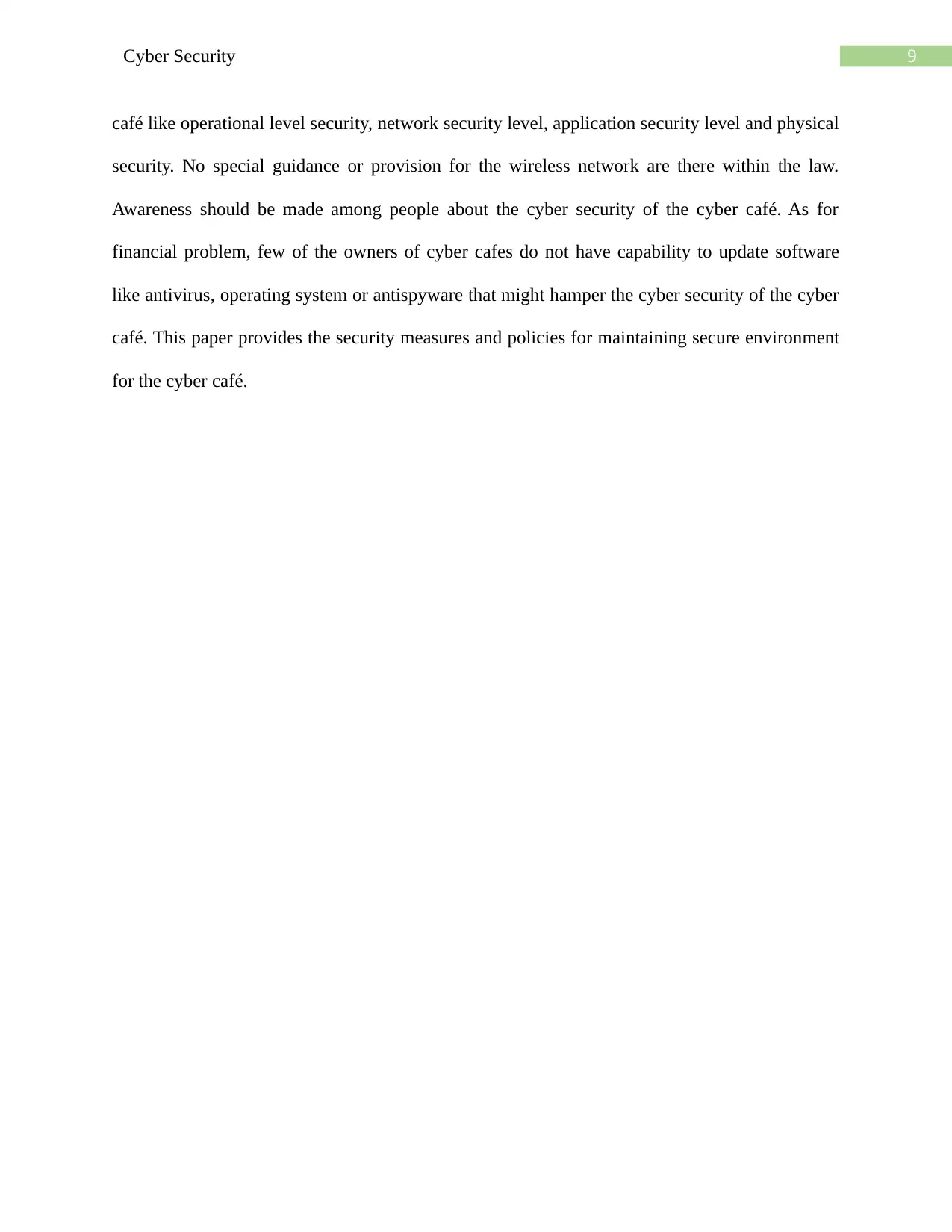
9Cyber Security
café like operational level security, network security level, application security level and physical
security. No special guidance or provision for the wireless network are there within the law.
Awareness should be made among people about the cyber security of the cyber café. As for
financial problem, few of the owners of cyber cafes do not have capability to update software
like antivirus, operating system or antispyware that might hamper the cyber security of the cyber
café. This paper provides the security measures and policies for maintaining secure environment
for the cyber café.
café like operational level security, network security level, application security level and physical
security. No special guidance or provision for the wireless network are there within the law.
Awareness should be made among people about the cyber security of the cyber café. As for
financial problem, few of the owners of cyber cafes do not have capability to update software
like antivirus, operating system or antispyware that might hamper the cyber security of the cyber
café. This paper provides the security measures and policies for maintaining secure environment
for the cyber café.
Secure Best Marks with AI Grader
Need help grading? Try our AI Grader for instant feedback on your assignments.
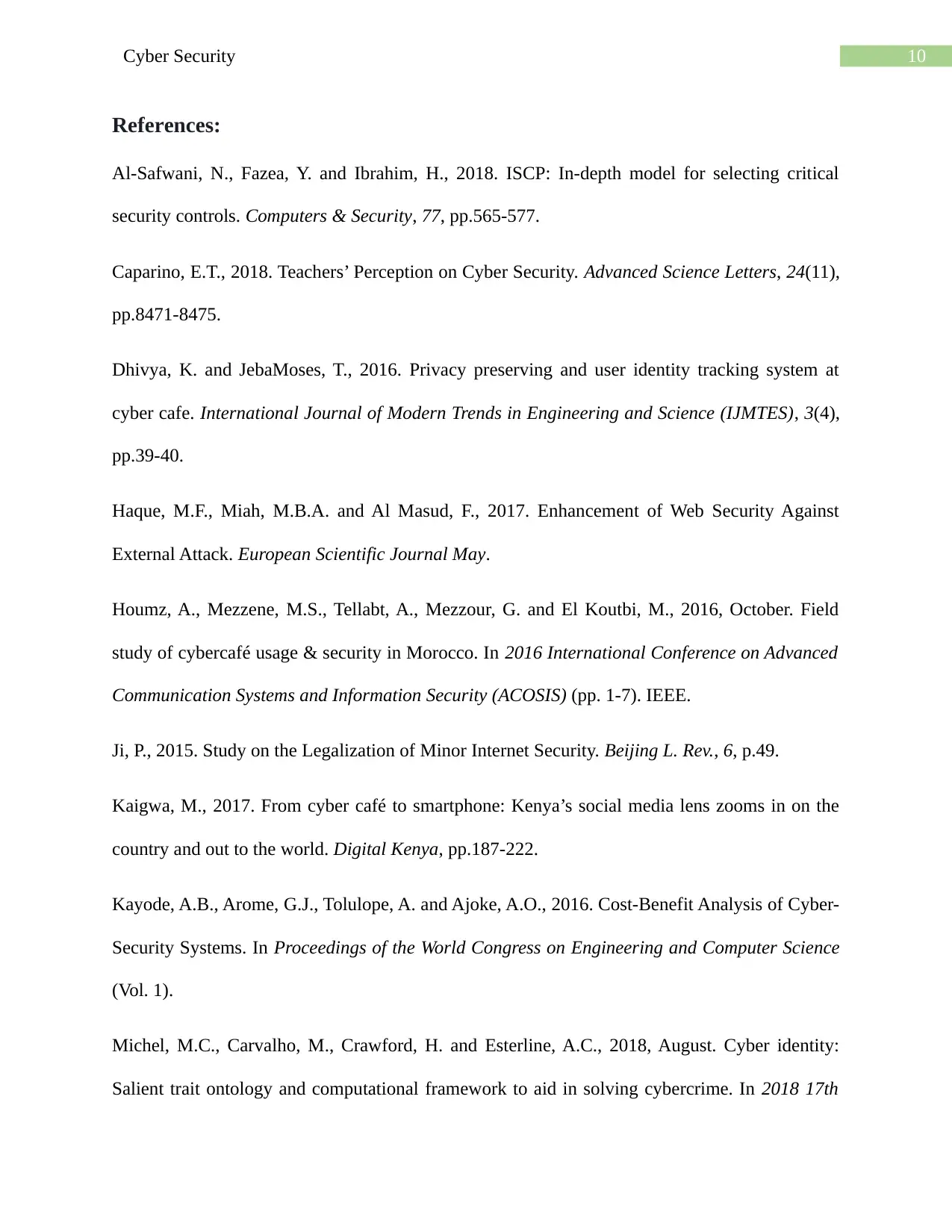
10Cyber Security
References:
Al-Safwani, N., Fazea, Y. and Ibrahim, H., 2018. ISCP: In-depth model for selecting critical
security controls. Computers & Security, 77, pp.565-577.
Caparino, E.T., 2018. Teachers’ Perception on Cyber Security. Advanced Science Letters, 24(11),
pp.8471-8475.
Dhivya, K. and JebaMoses, T., 2016. Privacy preserving and user identity tracking system at
cyber cafe. International Journal of Modern Trends in Engineering and Science (IJMTES), 3(4),
pp.39-40.
Haque, M.F., Miah, M.B.A. and Al Masud, F., 2017. Enhancement of Web Security Against
External Attack. European Scientific Journal May.
Houmz, A., Mezzene, M.S., Tellabt, A., Mezzour, G. and El Koutbi, M., 2016, October. Field
study of cybercafé usage & security in Morocco. In 2016 International Conference on Advanced
Communication Systems and Information Security (ACOSIS) (pp. 1-7). IEEE.
Ji, P., 2015. Study on the Legalization of Minor Internet Security. Beijing L. Rev., 6, p.49.
Kaigwa, M., 2017. From cyber café to smartphone: Kenya’s social media lens zooms in on the
country and out to the world. Digital Kenya, pp.187-222.
Kayode, A.B., Arome, G.J., Tolulope, A. and Ajoke, A.O., 2016. Cost-Benefit Analysis of Cyber-
Security Systems. In Proceedings of the World Congress on Engineering and Computer Science
(Vol. 1).
Michel, M.C., Carvalho, M., Crawford, H. and Esterline, A.C., 2018, August. Cyber identity:
Salient trait ontology and computational framework to aid in solving cybercrime. In 2018 17th
References:
Al-Safwani, N., Fazea, Y. and Ibrahim, H., 2018. ISCP: In-depth model for selecting critical
security controls. Computers & Security, 77, pp.565-577.
Caparino, E.T., 2018. Teachers’ Perception on Cyber Security. Advanced Science Letters, 24(11),
pp.8471-8475.
Dhivya, K. and JebaMoses, T., 2016. Privacy preserving and user identity tracking system at
cyber cafe. International Journal of Modern Trends in Engineering and Science (IJMTES), 3(4),
pp.39-40.
Haque, M.F., Miah, M.B.A. and Al Masud, F., 2017. Enhancement of Web Security Against
External Attack. European Scientific Journal May.
Houmz, A., Mezzene, M.S., Tellabt, A., Mezzour, G. and El Koutbi, M., 2016, October. Field
study of cybercafé usage & security in Morocco. In 2016 International Conference on Advanced
Communication Systems and Information Security (ACOSIS) (pp. 1-7). IEEE.
Ji, P., 2015. Study on the Legalization of Minor Internet Security. Beijing L. Rev., 6, p.49.
Kaigwa, M., 2017. From cyber café to smartphone: Kenya’s social media lens zooms in on the
country and out to the world. Digital Kenya, pp.187-222.
Kayode, A.B., Arome, G.J., Tolulope, A. and Ajoke, A.O., 2016. Cost-Benefit Analysis of Cyber-
Security Systems. In Proceedings of the World Congress on Engineering and Computer Science
(Vol. 1).
Michel, M.C., Carvalho, M., Crawford, H. and Esterline, A.C., 2018, August. Cyber identity:
Salient trait ontology and computational framework to aid in solving cybercrime. In 2018 17th
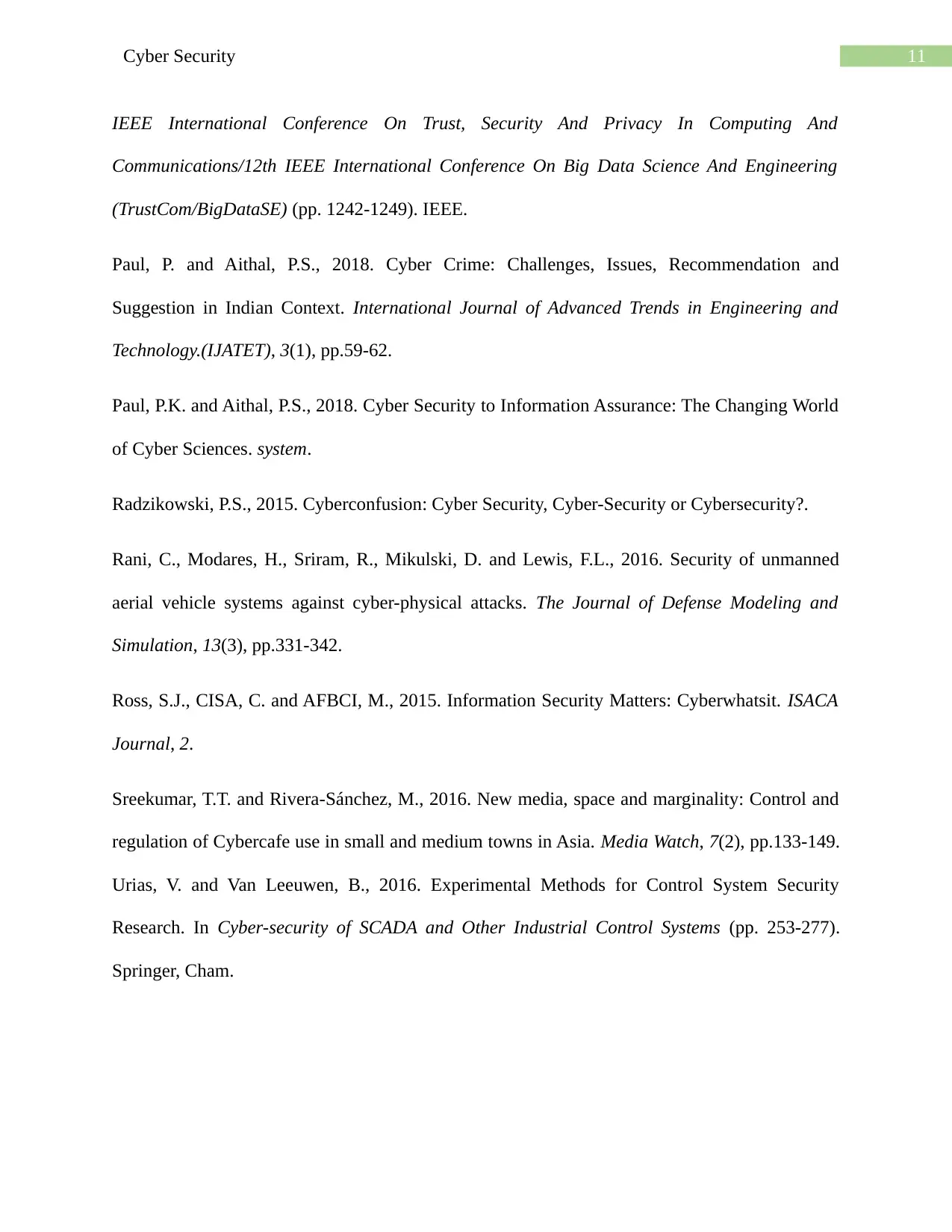
11Cyber Security
IEEE International Conference On Trust, Security And Privacy In Computing And
Communications/12th IEEE International Conference On Big Data Science And Engineering
(TrustCom/BigDataSE) (pp. 1242-1249). IEEE.
Paul, P. and Aithal, P.S., 2018. Cyber Crime: Challenges, Issues, Recommendation and
Suggestion in Indian Context. International Journal of Advanced Trends in Engineering and
Technology.(IJATET), 3(1), pp.59-62.
Paul, P.K. and Aithal, P.S., 2018. Cyber Security to Information Assurance: The Changing World
of Cyber Sciences. system.
Radzikowski, P.S., 2015. Cyberconfusion: Cyber Security, Cyber-Security or Cybersecurity?.
Rani, C., Modares, H., Sriram, R., Mikulski, D. and Lewis, F.L., 2016. Security of unmanned
aerial vehicle systems against cyber-physical attacks. The Journal of Defense Modeling and
Simulation, 13(3), pp.331-342.
Ross, S.J., CISA, C. and AFBCI, M., 2015. Information Security Matters: Cyberwhatsit. ISACA
Journal, 2.
Sreekumar, T.T. and Rivera-Sánchez, M., 2016. New media, space and marginality: Control and
regulation of Cybercafe use in small and medium towns in Asia. Media Watch, 7(2), pp.133-149.
Urias, V. and Van Leeuwen, B., 2016. Experimental Methods for Control System Security
Research. In Cyber-security of SCADA and Other Industrial Control Systems (pp. 253-277).
Springer, Cham.
IEEE International Conference On Trust, Security And Privacy In Computing And
Communications/12th IEEE International Conference On Big Data Science And Engineering
(TrustCom/BigDataSE) (pp. 1242-1249). IEEE.
Paul, P. and Aithal, P.S., 2018. Cyber Crime: Challenges, Issues, Recommendation and
Suggestion in Indian Context. International Journal of Advanced Trends in Engineering and
Technology.(IJATET), 3(1), pp.59-62.
Paul, P.K. and Aithal, P.S., 2018. Cyber Security to Information Assurance: The Changing World
of Cyber Sciences. system.
Radzikowski, P.S., 2015. Cyberconfusion: Cyber Security, Cyber-Security or Cybersecurity?.
Rani, C., Modares, H., Sriram, R., Mikulski, D. and Lewis, F.L., 2016. Security of unmanned
aerial vehicle systems against cyber-physical attacks. The Journal of Defense Modeling and
Simulation, 13(3), pp.331-342.
Ross, S.J., CISA, C. and AFBCI, M., 2015. Information Security Matters: Cyberwhatsit. ISACA
Journal, 2.
Sreekumar, T.T. and Rivera-Sánchez, M., 2016. New media, space and marginality: Control and
regulation of Cybercafe use in small and medium towns in Asia. Media Watch, 7(2), pp.133-149.
Urias, V. and Van Leeuwen, B., 2016. Experimental Methods for Control System Security
Research. In Cyber-security of SCADA and Other Industrial Control Systems (pp. 253-277).
Springer, Cham.
1 out of 12
Related Documents
Your All-in-One AI-Powered Toolkit for Academic Success.
+13062052269
info@desklib.com
Available 24*7 on WhatsApp / Email
![[object Object]](/_next/static/media/star-bottom.7253800d.svg)
Unlock your academic potential
© 2024 | Zucol Services PVT LTD | All rights reserved.





